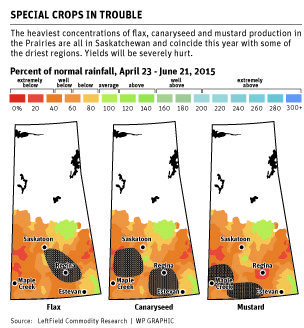CALGARY — Expect below average yields for Canada’s flax, canaryseed and mustard crops, says an industry analyst.
Chuck Penner, analyst with LeftField Commodity Research, said production of all three crops is concentrated in the driest areas of the Prairies.
“I don’t think there’s any way we can get to average yields for this year’s flax crop,” he said in a presentation to delegates attending the Pulse & Special Crops Convention.
Read Also

Huge Black Sea flax crop to provide stiff competition
Russia and Kazakhstan harvested huge flax crops and will be providing stiff competition in China and the EU.
Penner sees 800,000 tonnes of production, well below Agriculture Canada’s estimate of 920,000 tonnes, despite having a higher acreage number than Statistics Canada.
Prices could really take off if the Canadian crop gets any worse because he is forecasting steady demand from China, which has become the top customer for Canadian flax. European demand will likely be down because of prospects of a record Black Sea harvest. U.S. demand will also subside because of a big U.S. crop on the way.
Penner has no problems with Statistics Canada’s estimate for 320,000 acres of canaryseed.
Yields will be down because much of the crop is grown in west-central Saskatchewan and south of Regina, two of the driest areas of the Prairies.
Crop conditions as of June 15 were 43 percent good to excellent, which is well below the 10-year average of 69 percent.
He is forecasting 165,000 tonnes of production, which is what Canada typically exports annually.
“It’s finally going to get tight,” said Penner.
Kevin Dick, president of AC Trading, thinks area could be as high as 400,000 acres because many switched out of wheat into canaryseed. He agreed that yields will be down because canaryseed is a crop that needs good moisture.
“If we do have poor yields in some of the key growing areas, there could definitely be a move on canaryseed (prices),” said Dick.
Penner believes growers planted 400,000 acres of mustard, which is well above Statistics Canada’s estimate of 320,000 acres.
A lot of mustard is also grown in the dry areas. Crop condition was 33 percent good to excellent as of June 15, well below the 10-year average of 73 percent.
“It’s in trouble,” he said.
Penner is forecasting 160,000 tonnes of production, which is slightly less than what is typically used.
Prices for brown, yellow and oriental mustard are all heading higher.
“We’re starting to get tight on supplies,” he said.
Dick said Eastern Europe has increased production, growing mostly yellow mustard, which is keeping a cap on prices.
Black Sea mustard quality is much lower than Canadian quality, but European millers can work with it.
Mustard prices could rise if it doesn’t rain in Western Canada, but growers shouldn’t count on “crazy” prices of 70 cents per pound because of the influx of Black Sea mustard in the European market, said Dick.
Penner’s bean outlook was lacklustre because North American supply should balance out demand.
It is a similar situation in Mexico, where prices indicate the trade is not worried about tightness but also not fearful of being over-supplied.
Prices have crashed in Argentina because there is a good crop on the way after last year’s disaster. He expects 500,000 tonnes of production with the biggest increase in black beans.
White bean prices have steadily decreased with good crops coming in North American and Argentina, which points to further weakness ahead.
Penner expects coloured bean prices to perform better than white and black beans in 2015-16.
He initially anticipated 185,000 acres of fababeans in Canada, but after talking to traders dropped that estimate to 125,000 to 150,000 acres.
It should be enough for a 155,000 tonne crop, but yields are suspect because fababeans like moisture.
Prices have softened around the world because of the expectation for good crops in Australia, France and the United Kingdom.
Penner believes Canadian growers planted 125,000 acres of sunflowers, with 70 percent of that being confectionary type and 30 percent oil type.
The U.S. is the big driver for sunflower prices, and growers in that country planted more oil types and fewer confectionary types.
“We’re going to see more strength in confecs than oils,” said Penner.


















